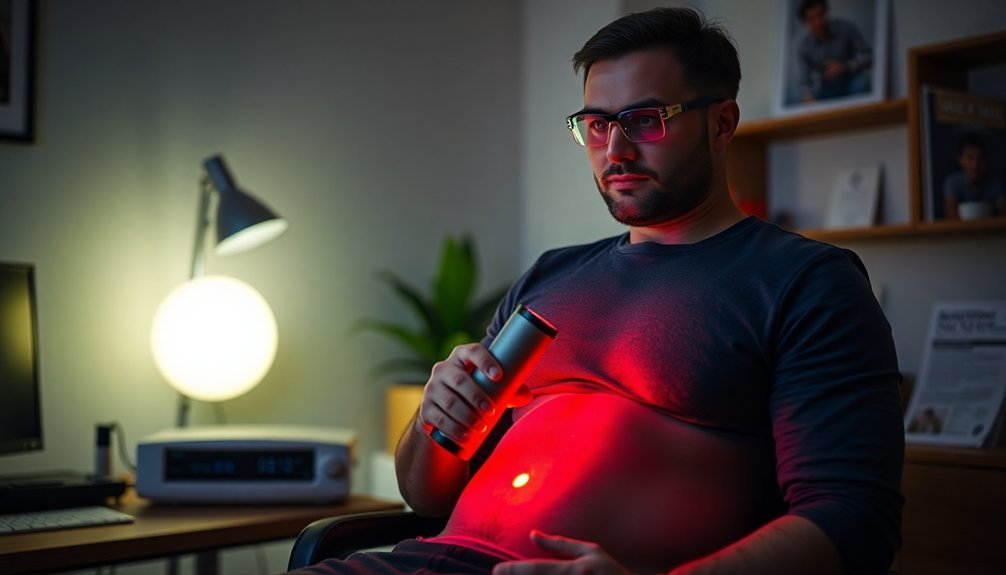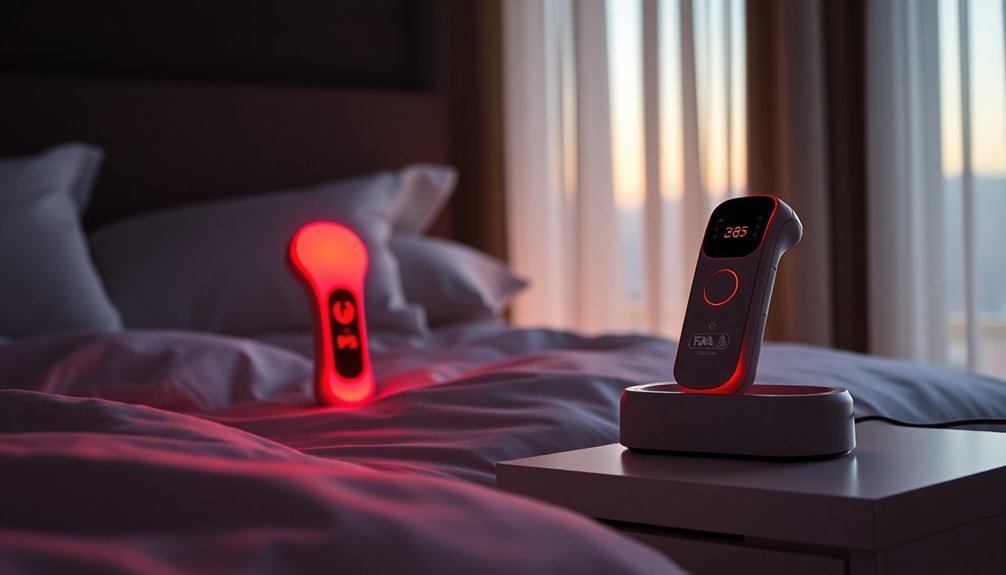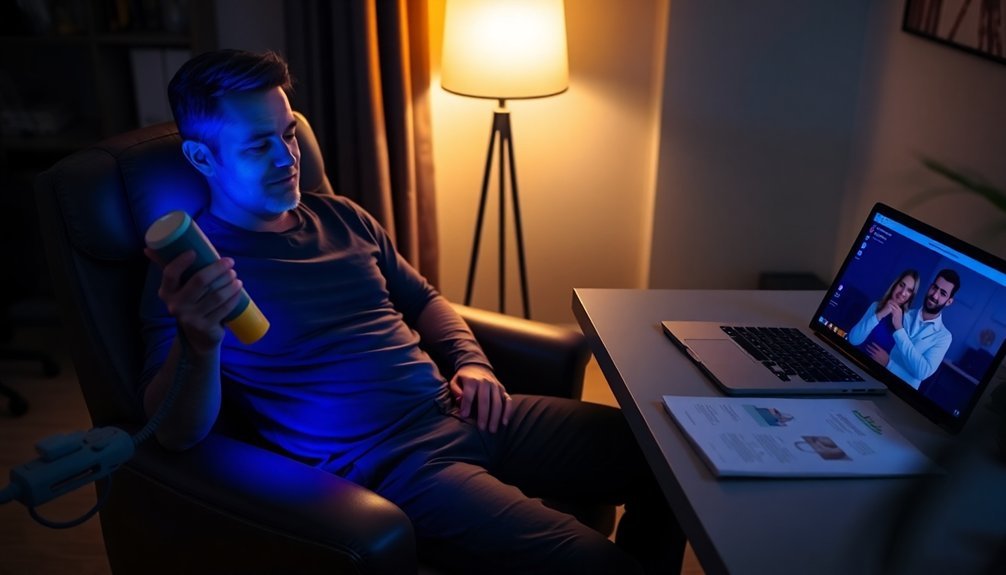Red light therapy can substantially boost your fertility through convenient at-home laser sessions. Using specific wavelengths around 670nm, these treatments stimulate your sperm cells' mitochondria, increasing energy production and improving overall sperm health. You'll typically see benefits like enhanced motility, higher sperm counts, and better sperm quality after consistent use. The process works by activating Cytochrome C Oxidase in sperm cells while reducing harmful reactive oxygen species. For best results, combine your laser therapy with fertility-supporting lifestyle changes like a nutrient-rich diet and stress management. Understanding the science and proper techniques will help maximize your treatment's effectiveness.
Understanding Male Fertility Basics

Inside the male reproductive system, three key hormones orchestrate the complex process of fertility: FSH, LH, and testosterone. FSH stimulates sperm production in your testes, while LH triggers testosterone production, which maintains your male characteristics and supports overall reproductive health.
Your body's sperm production is a meticulous process that takes up to three months to complete. Once produced in the testes, sperm cells move to the epididymis, where they're stored and nourished until they become motile. The vas deferens tube transports mature sperm from the epididymis to the urethra.
When you ejaculate, these sperm combine with fluids from the seminal vesicles and prostate gland to form semen.
For ideal fertility, you'll need healthy sperm counts of at least 40 million, with 15-20 million per milliliter being the normal concentration. Additionally, at least 40% of your sperm should be motile to achieve pregnancy.
These sperm can survive in the female reproductive tract for 48-72 hours after intercourse.
Your pituitary gland plays a vital role by regulating the hormones necessary for sperm production. Any hormone imbalances can substantially impact your fertility by disrupting both sperm production and quality.
Red Light Therapy Science
The science behind red light therapy reveals a powerful cellular mechanism for boosting male fertility. When red light at 670nm wavelength penetrates your tissue, it activates an enzyme called Cytochrome C Oxidase in your sperm cells' mitochondria. This activation triggers a cascade of beneficial effects that directly enhance your reproductive health.
Your sperm cells' mitochondria respond by producing more ATP, the energy currency they need for proper movement and function. At the same time, the therapy reduces harmful reactive oxygen species (ROS) that can damage sperm cells and impair fertility.
The treatment also improves your Sertoli cells' performance, which are essential for healthy sperm production. One remarkable study from Denmark showed that sperm counts jumped from 2 million to 40 million per milliliter after a single treatment.
Clinical studies demonstrate that you'll see significant improvements in sperm motility and concentration after just one session. The therapy can increase your sperm counts by 2-5 times if you're experiencing low counts, and it reduces the number of abnormal sperm cells.
Most importantly, this non-invasive treatment works quickly – you may notice improvements within an hour. Using LED-based devices guarantees you'll get these benefits without harmful heat exposure, making it a safe and effective option for enhancing your fertility.
Laser Treatment Benefits

After completing a series of laser treatment sessions, you'll experience multiple significant benefits for male fertility. The therapy works by stimulating your body's natural processes, enhancing ATP production in sperm cells, and improving blood flow to reproductive tissues. Regular treatments every 6 weeks provide optimal results for ongoing reproductive health.
You'll likely notice improvements in sperm count, with studies showing increases of 2-5 times in oligospermic patients. The treatment also enhances sperm quality by reducing abnormalities and boosting motility.
What makes laser therapy particularly appealing is its proven safety record and lack of adverse side effects. The treatment promotes tissue repair while reducing inflammation and oxidative damage, creating ideal conditions for sperm production and health. You'll benefit from improved mitochondrial function, which is essential for sperm energy and mobility.
- Your sperm count can increase by 200-500% if you're oligospermic
- You'll see enhanced sperm motility and better morphology
- Your ejaculate volume may increase, along with improved libido
- The treatment reduces inflammation and oxidative stress
- You'll benefit from increased ATP production and better blood flow
Starting Your At-Home Sessions
Now that you understand the benefits, setting up your at-home laser therapy sessions requires careful preparation and attention to detail. Start by selecting a certified LED device that emits red light at 670nm wavelength, which research shows is ideal for improving sperm health.
Choose a quiet, cool location in your home where you won't be disturbed during treatments.
Begin with short sessions and gradually increase the duration as you become comfortable with the treatment. You'll want to monitor the temperature of both the device and the treatment area, as excess heat can harm sperm production. Targeting the testes with light therapy can enhance ATP production in sperm cells, which is essential for successful fertilization.
Keep track of your progress using at-home sperm motility tests, and adjust your protocol based on the results you observe.
Remember to combine your light therapy with positive lifestyle changes. Maintain a healthy weight, quit smoking, limit alcohol consumption, and manage your stress levels to maximize the treatment's effectiveness.
Don't forget to clean your device regularly and follow the manufacturer's maintenance instructions. If you experience any unusual effects or have concerns during treatment, don't hesitate to consult your healthcare provider for guidance.
Choosing The Right Device

When you're selecting a device for male fertility treatment, you'll need to focus on specific features like wavelength (620-670nm) and power output to guarantee effectiveness.
While clinical-grade lasers offer the most proven results, they're not suitable for home use due to safety concerns and high costs.
Your safest option is to look for LED devices with proper safety certifications that operate in the correct wavelength range, though you should understand they won't match the power of clinical equipment.
Device Features Matter Most
The fertility-boosting power of laser therapy largely depends on choosing a device with the right technical specifications.
When selecting a device, you'll want to focus on ones that use LED technology with specific wavelengths of red light (635 nm) and infrared (904 nm), as these have proven most effective for improving sperm motility and count. Your device should maintain a temperature below 95°F to protect testicular function and feature a contoured design that fits closely to your skin for maximum light absorption.
Pay attention to these critical features for maximum effectiveness:
- Light intensity settings that you can adjust based on your specific needs and comfort level
- Temperature control mechanisms to prevent overheating during treatment sessions
- A compact, portable design that makes regular at-home treatments convenient
- Clear indicators for treatment duration and frequency to guarantee proper usage
- Easy-to-clean surfaces and straightforward maintenance requirements
Remember that devices backed by clinical research and professional endorsements typically offer the most reliable results. Look for models that provide detailed user guidelines and responsive customer support to guarantee you're getting the most from your investment in fertility improvement.
Safety Certifications and Standards
Proper safety certifications serve as your first line of defense when selecting a fertility-boosting laser device. When evaluating options, you'll want to confirm FDA approval, which has been standard for home fertility tests using laser technology since 2012.
Make sure the device adheres to World Health Organization (WHO) standards for semen analysis, as this guarantees reliable results.
Look for devices that have undergone rigorous clinical validation through documented studies. This validation process should demonstrate both the device's effectiveness and safety in real-world applications.
Pay particular attention to laser safety specifications, ensuring the device uses appropriate intensities and wavelengths that won't harm your skin or eyes.
Before making your purchase, verify that the manufacturer provides thorough clinical trial data and peer-reviewed studies published in respected medical journals. Professional endorsements from healthcare professionals and fertility specialists add another layer of credibility to the device's safety profile.
Optimal Treatment Protocols
Successful laser therapy for male fertility relies on carefully structured treatment protocols that maximize therapeutic benefits. You'll need three initial treatments to see improvements in sperm count, with sessions scheduled twice weekly. These treatments utilize both high-power Class 3B and low-power Class 2 lasers to target reproductive tissue effectively.
For the best results, you'll want to follow these treatment guidelines to enhance your fertility potential:
- Complete a minimum of 6 sessions over 2 weeks, adjusting frequency based on your response to treatment.
- Schedule your sessions consistently, ideally at the same times each week.
- Avoid treatments if you're taking photosensitive medications or immunosuppressive drugs.
- Combine laser therapy with acupuncture when possible for enhanced results.
- Consider LED panel treatments at home between clinical sessions for continuous support.
Treatment costs typically range from $45 to $120 per session, with package deals offering better value. If you're preparing for IVF or other fertility procedures, you should begin laser treatments at least two weeks before your scheduled procedure.
Remember that while improvements can be seen after three sessions, a full course of treatment guarantees the best possible outcomes.
Lifestyle Changes For Success

Maximizing the benefits of laser fertility treatments depends heavily upon implementing supportive lifestyle changes. You'll need to focus on four key areas: diet, exercise, stress management, and harmful substance avoidance.
Your diet should emphasize dark vegetables, fruits, and tree nuts rich in polyunsaturated fats while limiting processed foods and red meat. Include zinc and antioxidant-rich foods to support sperm production.
You'll want to exercise moderately for at least 30 minutes daily, combining cardio and resistance training, but avoid overexertion that could lower testosterone levels.
Don't underestimate the importance of quality sleep and stress management. Aim for six or more hours of sleep nightly to support your pituitary gland's function in sperm production.
Practice stress-reducing activities regularly, as high stress levels can substantially impair fertility.
You'll need to eliminate harmful substances that can compromise your fertility. Quit smoking, limit alcohol to 1-2 drinks weekly, and avoid marijuana use. Stay away from performance-enhancing supplements and minimize exposure to environmental toxins.
These lifestyle modifications will help optimize your laser treatment outcomes and improve your overall fertility potential.
Enhancing Sperm Quality
Modern laser treatments offer a powerful solution to improve your sperm's motility through laser-assisted selection of immotile sperm (LAISS) technology.
You'll find this cutting-edge approach targets specific features like shape and movement patterns, leading to better-quality sperm selection for fertility treatments.
When combined with photobiomodulation using LED light therapy, you can expect enhanced sperm mobility, particularly if you're dealing with asthenozoospermia.
Laser Impact on Motility
Three groundbreaking discoveries have shown that low-level laser therapy substantially enhances sperm motility, particularly in men with oligospermia and asthenospermia. The treatment uses 905 nm infrared laser light at 50 mW/cm² for just 30 seconds, targeting light-sensitive cytochrome c oxidase in your sperm's mitochondria.
You'll see improvements in as little as 30 minutes after treatment, with asthenospermic samples showing up to 85% increased motility.
What's particularly encouraging is that this treatment doesn't damage your sperm's DNA. The laser light works by enhancing the mitochondrial electron transport chain, suggesting that some fertility issues may be linked to mitochondrial dysfunction. While normospermic samples show less dramatic improvements, the results are still positive.
- Your sperm's motility can improve within 30 minutes of treatment
- The therapy uses safe infrared light that won't harm sperm DNA
- Asthenospermic samples show the most dramatic improvement at 85%
- Treatment requires only 30 seconds of exposure at body temperature
- Results are particularly effective for men with low sperm count or poor motility
Scientists are now exploring clinical applications, though more research is needed to understand long-term effects and standardize treatment protocols for consistent results.
Key Fertility Parameters
A man's fertility potential hinges on several critical sperm parameters that doctors use to evaluate reproductive health. When you're trying to conceive, your healthcare provider will examine three main factors: sperm count, motility, and morphology.
Your sperm count should be at least 15 million per milliliter, with fertile men typically averaging around 67 million per milliliter. If your count drops below 13.5 million, you might face fertility challenges.
Sperm motility, or the ability of sperm to swim effectively, needs to be 42% or higher. When motility falls below 32%, it can substantially impact your chances of conception.
Sperm morphology, which refers to the shape and structure of sperm cells, should be at least 4% normal forms.
You'll want to maintain these parameters through healthy lifestyle choices. A diet rich in omega-3 fatty acids can boost sperm count, while reducing saturated fats and trans-fatty acids helps preserve motility. You should also limit alcohol and quit smoking, as these habits can harm sperm quality.
Including antioxidant-rich foods and maintaining adequate zinc and vitamin D levels will support overall sperm health.
Daily Treatment Benefits
Laser therapy sessions can dramatically improve your sperm quality through daily treatments. Research shows that even a single session can markedly boost sperm motility, while consistent treatments can increase your sperm count by 2-5 times.
You'll benefit from enhanced mitochondrial activity and ATP production, which directly impacts your sperm cells' swimming ability and overall reproductive health.
Clinical studies demonstrate that regular LLLT treatments can transform your fertility parameters, with some patients seeing sperm counts rise from 2 million to over 40 million per ml. The non-heating laser light targets specific areas to optimize reproductive function and improve Sertoli Cell performance in your testes.
- Your sperm motility can increase by up to 85% with targeted LLLT sessions
- You'll see improvements in sperm morphology by approximately 25% after 15 treatments
- Your sperm count could multiply several times with consistent therapy
- You'll benefit from enhanced mitochondrial energy production in sperm cells
- Your fertility outcomes may improve when combining LLLT with other treatments like PRP
These evidence-based improvements make LLLT an effective option for addressing male fertility challenges, particularly when you're dealing with low sperm counts or reduced motility.
Tracking Your Progress

Throughout your fertility treatment journey, tracking progress becomes essential through various medical assessments and monitoring methods. You'll need to undergo regular blood work and ultrasound scans to monitor your treatment's effectiveness and detect any potential complications.
To track your sperm quality improvements, you'll receive thorough semen analyses that measure critical parameters including sperm count, motility, and morphology. Your healthcare provider may use specialized techniques like the hypo-osmotic swelling test or birefringence-polarization microscopy to assess sperm viability and quality more thoroughly.
While following your treatment plan, it's vital to document lifestyle changes and their impact on your fertility. Keep track of your supplement intake, exercise routine, and dietary modifications.
You should note any changes in habits like reducing alcohol consumption, quitting smoking, or avoiding excessive heat exposure to the testicles.
Make sure to communicate regularly with your healthcare provider about your progress and any side effects you're experiencing. They'll help adjust your treatment plan based on your test results and personal response to the therapy.
Remember to schedule morning monitoring appointments and expect same-day feedback on your blood work results.
Safety Guidelines
Always follow the manufacturer's guidelines when operating the fertility laser device, keeping it at the specified distance from the skin and using only approved power settings.
You'll need to monitor treatment duration carefully, never exceeding recommended session times to prevent tissue overheating.
For your safety, stop the treatment immediately if you experience any discomfort or unusual warmth, and make certain you're using proper protective eyewear during each session.
Proper Device Operation Protocol
Three essential safety protocols must be followed when operating fertility laser devices. First, you'll need to wear protective eyewear during every session to shield your eyes from potential laser damage.
Second, verify you're using the correct power settings to deliver exactly 10 Joules per testicle.
Third, maintain strict cleanliness of the device according to manufacturer guidelines to prevent any risk of infection.
For ideal results and safety during your treatment sessions, follow these key operational steps:
- Position the device at the recommended distance and angle, verifying proper contact with the treatment area
- Apply the laser for exactly 2 x 10 seconds per testicle, following the prescribed treatment protocol
- Monitor the device's power output and timing to maintain consistent dosage levels
- Clean and disinfect the device before and after each use with manufacturer-approved methods
- Store the device in a secure location away from children and unauthorized users
Remember to strictly follow the manufacturer's guidelines from reputable companies like PowerMedic ApS. If you're combining laser therapy with other fertility treatments, maintain detailed records of your sessions and communicate any concerns with your healthcare provider.
Never exceed the recommended treatment duration or frequency.
Heat and Duration Limits
Understanding heat and duration limits is essential for safe at-home fertility laser treatments. When using therapeutic lasers for fertility enhancement, you'll need to carefully monitor both heat exposure and session duration to protect your reproductive health.
Excessive heat can impair sperm quality and motility, so it's vital to avoid overheating the genital area during treatments.
For Class 3B and Class 4 therapeutic lasers, you'll need to follow strict exposure time limits due to their higher power outputs. If you're using a Class 3B device, make certain it stays within the 5 mW to 0.5 W power range. For Class 4 devices, which operate above 0.5 W, you'll need to be especially vigilant about exposure times and always wear appropriate protective eyewear.
During your sessions, you should operate the laser in a well-ventilated area and remove any reflective objects from the beam path. Don't direct the beam upward, and use diffuse reflecting beam blocks for proper beam termination.
Always follow your healthcare provider's recommended treatment protocol and manufacturer guidelines for session duration and frequency. If you notice any unusual heat buildup or discomfort, stop the treatment immediately.
Professional Support Options

Men facing fertility challenges have access to an extensive network of professional support services. You'll find specialized fertility centers staffed with urologists, fertility specialists, and clinical embryologists who can create personalized treatment plans based on your specific needs.
These experts use advanced diagnostic tools and treatments, from hormone therapy to surgical interventions, guaranteeing you receive thorough care throughout your fertility journey.
Working with professionals gives you access to proven medical treatments and cutting-edge technologies. Your healthcare team can monitor your progress through regular blood tests, adjust medications as needed, and implement advanced procedures like IUI or IVF when appropriate.
- Fertility specialists can prescribe targeted medications to correct hormone imbalances and boost sperm production
- Clinical embryologists use state-of-the-art equipment to identify and select healthy sperm
- Urologists offer surgical solutions for structural issues affecting fertility
- Professional counselors provide emotional support during your treatment journey
- Healthcare teams can guide you through lifestyle modifications that enhance fertility
While pursuing at-home treatments, maintaining contact with fertility professionals guarantees you're taking a well-rounded approach to improving your fertility. They'll help monitor your progress and adjust your treatment plan as needed for the best results.
Long-Term Treatment Strategies
Building on your professional medical support, a thorough long-term strategy for laser fertility treatment combines regular LLLT sessions with sustained lifestyle improvements.
Your treatment plan should incorporate 808 nm wavelength LLLT sessions at an energy density of 28 J/cm2, which has proven effective for improving sperm quality and motility over time.
You'll need to commit to consistent treatments while implementing complementary lifestyle changes. Focus on maintaining a healthy weight, incorporating regular physical activity, and adopting stress reduction techniques. These changes work synergistically with LLLT to enhance your fertility outcomes.
Consider adding fertility-supporting supplements like D-aspartic acid to your daily routine, but always consult your healthcare provider first.
Monitor your progress through regular semen analysis to track improvements in sperm parameters and DNA fragmentation levels. You may see enhanced results by combining LLLT with other prescribed fertility treatments.
Remember that while laser therapy shows promising long-term efficacy for treating conditions like chronic prostatitis and oligospermia, you'll achieve the best results by maintaining your lifestyle improvements throughout the treatment period.
Stay committed to your plan and maintain open communication with your healthcare provider to adjust the protocol as needed.
Frequently Asked Questions
Can Laser Therapy Help if I've Had a Vasectomy Reversed?
You can't rely on laser therapy after vasectomy reversal. There's no scientific evidence that lasers help restore fertility. Focus on following your doctor's post-surgery care plan for the best recovery outcomes.
Will Laser Therapy Affect My Partner's Fertility During Intercourse?
No, laser therapy won't affect your partner's fertility during intercourse. The treatment's effects are localized to your reproductive system only, and there's no evidence showing any impact on your partner's fertility.
Should I Stop Other Fertility Medications When Starting Laser Therapy?
Don't stop your current fertility medications when starting laser therapy. You should continue them unless your doctor advises otherwise. Always consult your healthcare provider about potential interactions between treatments before making changes.
Does Wearing Tight Underwear Reduce the Effectiveness of Laser Treatment?
Yes, tight underwear could reduce your laser treatment's effectiveness since it raises scrotal temperature. You'll get better results if you wear loose-fitting underwear during and between treatments to maintain ideal testicular temperature.
Can I Use Laser Therapy While Taking Testosterone Replacement Supplements?
You shouldn't combine laser therapy with testosterone replacement without consulting your doctor first. While laser therapy is generally safe, TRT can affect sperm production, and the combination needs professional monitoring for safety.
In Summary
Using at-home laser therapy offers you a promising path to boost your fertility naturally. You'll need patience, consistency, and proper safety protocols to see the best results. While red light treatments can enhance sperm health and motility, remember to work with your doctor to monitor progress. When you combine these sessions with a healthy lifestyle, you're taking proactive steps toward your fertility goals.





Leave a Reply